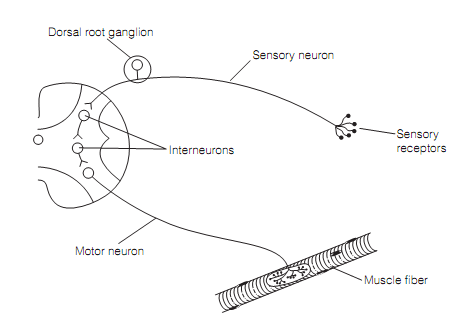Properties of reflexes
The simplest operation the nervous system can execute is the reflex that couples sensory input to motor output. A reflex is a stereo-typed response to a specific stimulus. Whenever it includes the autonomic nervous system it is an autonomic reflex and the effector is usually cardiac or smooth muscle or a gland. Whenever it takes place in the somatic nervous system it is a motor reflex and the effector is skeletal muscle. They are mediated by particular neural circuits sometimes reflex known as arcs as shown in figure below, that consist of a sensory neuron, a motor neuron and generally interneuron interposed between the two, that might be excitatory or inhibitory.

Figure: A polysynaptic spinal motor reflex arc.
Reflex arcs with two or more inter neurons should have three or more central synapses as shown in figure above and are said to be polysynaptic. When there is only one interneuron then the reflex is disynaptic. The only illustration of a monosynaptic reflex, where there is no interneuron, in the stretch reflex.
A sensory neuron will form synapses with numerous interneuron (or motor neurons in the situation of a monosynaptic reflex). Generally the effect of afferent firing is to generate quite large epsps on a few neurons and many modest epsps in a bigger group, based on the number of synapses. The connections made by numerous sensory neurons on interneurons overlap and this gives for the possibility of integration. This integration is frequently nonlinear; that is, the excitation of the motor neuron can be bigger than the sum of the facilitation, individual inputs or dominated by one input and therefore little affected by extra ones, occlusion.
The time between the stimulus and response is known as the reflex latency or reflex time. It outcomes chiefly from the conduction time along afferent and efferent fibers, although also involves the time taken for sensory transduction and for activation of the effector (muscle or gland). A little interval is taken up by the synaptic delay; generally between 0.5 and 1 ms. Whenever conduction time is taken into account, then reflex latencies reflect the number of central synapses.
Increasing the stimulus intensity will modify the amplitude of the reflex (example, the amount by which a limb moves) but might also modify the form of the response by recruiting extra muscles, this is known as irradiation. The exact form of the reflex response depends on exactly where the stimulus is applied and therefore which afferents are excited. This is known as the local sign.
Probably all reflexes can be altered by experience. The attenuation of reflex by the repeated application of a constant innocuous stimulus is habituation. It is caused by the synaptic depression. Any transform to the stimulus (example, in its intensity) causes dishabituation in which the reflex returns to its baseline state. By disparity, repeated application of a noxious stimulus can enhance a reflex; by reduce in latency, increased amplitude, or irradiation. This is termed as sensitization and outcomes from increased transmitter release. Both sensitization and habituation are illustrations of non-associative learning since only one stimulus is included. Some reflexes are able of the more complex associative learning, in which a response takes place if two stimuli are paired in time. These are accustomed reflexes.